1. Introduction
A mid-level manager opens her dashboard on Monday morning to find that an Al assistant has already compiled the team's weekly report, flagged two projects behind schedule, and even drafted performance feedback for each team member.
Just a few years ago, this scenario might have sounded like science fiction. Today, it's rapidly becoming a reality.
Advances in artificial intelligence (AI) are transforming the very nature of managerial work, performing many tasks that managers once handled manually.
This white paper examines the risks Al poses to managerial roles and how those risks can be converted into opportunities. It is aimed at mid-level managers in corporate roles, as well as HR and L&D leaders and executives who are preparing their organizations for the future.
We take a narrative-driven and empathetic look at the challenges, supported by data and case studies from leading research (McKinsey, Gartner, WEF, MIT Sloan, HBR, etc.) and real companies that have begun restructuring management because of Al.
Finally, we outline strategic solutions, from upskilling to organizational changes, that can empower managers to thrive in the age of Al, rather than be displaced by it.
The perspective here is clear: Al presents a serious threat to the status quo, but with the right approach, it can become a catalyst for positive change.
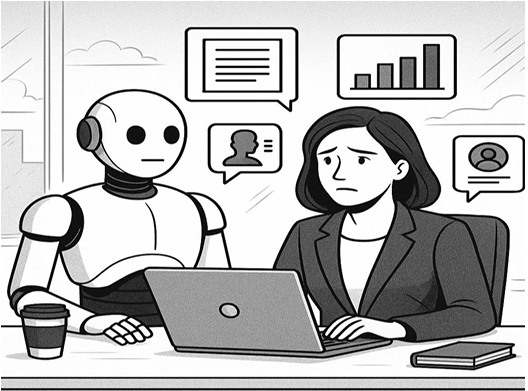
In this paper, you will find: an overview of how Al is automating managerial tasks and threatening middle-management positions; global case studies of companies leveraging Al in management (and lessons learned from their successes and missteps); a timeline of Al's encroachment into management; and actionable strategies for managers and organizations to adapt, upskill, and partner with Al. Throughout, we maintain a solution-focused, future-oriented outlook, one that acknowledges the disruption and anxiety, but also highlights a vision for augmented managers and new leadership paradigms.
2. AI's Threat to Mid-Level Management
Recent breakthroughs in Al, from advanced analytics to generative Al like ChatGPT, have dramatically expanded the range of tasks that can be automated. Many core activities that occupy managers' days are now within Al's capabilities. Al systems can instantly analyze data, track performance metrics, optimize schedules, and even draft communications, duties that traditionally consumed a significant portion of a manager's time.
The implications are sobering: if a manager's "primary value lies in organizing tasks, generating reports, and tracking KPIs, [their] role is under threat". Al can perform these functions faster, more accurately, and without bias.
In fact, Gartner analysts predicted back in 2020 that by 2024, nearly 69% of routine work done by managers would be fully automated. We are now at that juncture, and evidence is mounting that this prediction was on target.
Mid-level managers are often the "information hubs" of an organization, consolidating reports, monitoring workflows, and passing information up and down the hierarchy. These exact functions are prime targets for Al and algorithms. A global survey by Pegasystems found that 78% of executives believe increasing the use of Al and robots will dramatically reduce the ranks of middle management.
The economic motive is clear: experienced managers are costly, whereas Al tools (once implemented) are relatively cheap to operate and don't ask for raises or time off. As one commentator bluntly put it, "Al on the flipside is cost-effective... once you make the initial investment in Al, the cost of maintaining and upgrading it is significantly lower". In hard financial terms, if an Al system can handle the workload of a manager, companies may question the need to continue paying a six-figure salary for that role.
Which managerial tasks can Al handle today?
Quite a few, as it turns out. Some examples include:
- Data Analysis & Reporting: Al can crunch performance data and generate reports (sales trends, project status, etc.) in a fraction of the time a person would take. At Microsoft, CEO Satya Nadella revealed that Al already writes up to 30% of the company's code, and executives expect that number to reach 95% by 2030. If Al can produce complex software, it certainly can compile routine management reports.
- Scheduling & Resource Allocation: Modern Al scheduling tools automatically optimize shift rosters and project task assignments based on skills and availability. This was once the tedious work of project and operations managers. Al's algorithmic efficiency often outperforms human planners, eliminating a traditional managerial duty.
- Monitoring & Oversight: Tools powered by machine learning can now track team members' progress in real-time, flag anomalies, and even evaluate work quality against set criteria. For example, Al can listen to sales calls and provide feedback or monitor customer support chats and signal when escalation is needed, tasks that supervisors used to do manually by sample-checking or micromanaging.
- Initial HR Screening and Onboarding: Al has been successfully used to scan resumes and even conduct preliminary interviews through chatbots. It can identify top candidates from a flood of applications and automate onboarding paperwork, reducing the need for managers to spend time on hiring logistics.
- Approvals & Routine Decisions: Managers often spend time approving expense reports, vacation requests, or minor budget allocations. Al systems (or rule-based process automation) can approve routine requests automatically if they meet predefined criteria, only escalating exceptions to humans. This trims another portion of managers' routine workload.
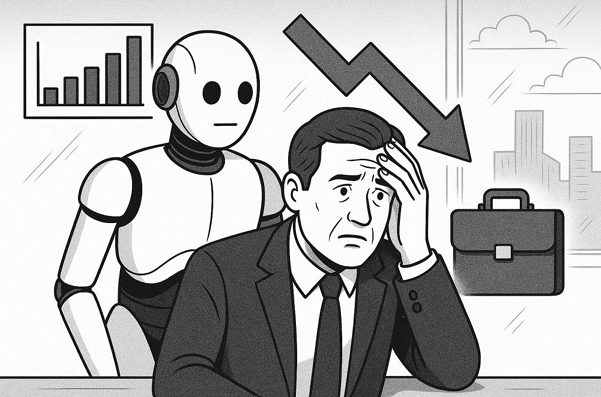
When you add it all up, it's easy to see why analysts talk about a coming "automation of management." By one estimate, "by 2030, Al will handle 80% of project management tasks," fundamentally changing the project manager's role. Gartner's forecast about automating the majority of managerial tasks is materializing across industries, from finance to manufacturing to tech. And unlike previous waves of automation that mostly affected blue-collar jobs, this wave is squarely aimed at white-collar, knowledge-worker roles, including managers.
As Axios grimly noted in 2023, we may be "sleepwalking into a white-collar bloodbath" as Al gains cognitive and decision-making abilities that encroach on office jobs. For mid-level managers, these trends trigger understandable anxiety. Many are asking:
Will I be next?
It's not an unfounded fear, in early 2025, Microsoft laid off 6,000 employees (about 3% of its workforce) as part of a restructuring that quietly pointed to Al efficiencies. Officially, the cuts were about streamlining layers of management, but insiders noted it's part of "the quiet rise of Al-induced job disruption". Notably, the layoffs hit certain manager roles disproportionately: more than 40% of those let go in Microsoft's home state were software engineers, but product managers and technical program managers were also heavily affected. These are roles that coordinate and synthesize functions increasingly augmented by Al. Microsoft's CTO Kevin Scott explicitly stated the rationale: if Al will soon write the vast majority of code, "what do you need a bunch of [human] engineers for?". By extension, if Al systems can coordinate projects and teams, the demand for managers could fall as well.

3. Impact on Organizations and the Workforce
The rise of Al in management is not happening in isolation, it's part of a broader transformation in how organizations are structured. Many companies are finding that Al enables leaner management layers and more autonomous teams. In practice, this means some traditional middle-management positions may be eliminated as their duties are absorbed by algorithms or by empowered frontline staff.
Even before the recent Al boom, there were signs of a management paradigm shift. A Boston Consulting Group (BCG) survey in 2020 found that a startling 37% of managers believed their entire management layer would disappear within five years. (That five-year horizon brings us to 2025, the present moment.) In the same survey, 63% of Western managers said they did not want to remain in management long-term, and a mere 9% of non-managers aspired to become managers. In BCG's words, "traditional management has reached a breaking point". Middle managers were already squeezed by increasing complexity, burnout, and employee disengagement, now add to that the existential threat of being automated. The result is a crisis of confidence and morale among many managers. They're asking themselves: Does my role truly add value, or will it be next on the chopping block?
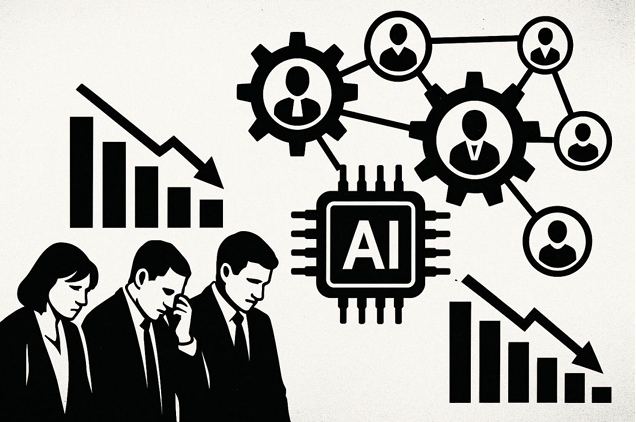
From an employee perspective, managers play a crucial role in mentoring, coordinating, and translating top-level strategy into execution. If those roles vanish or shrink, organizations risk losing critical glue in their culture. Yet, some organizations are actively questioning the necessity of certain management layers. The philosophy of "Agile" and self-managing teams, for instance, has demonstrated that flatter structures can outperform tall hierarchies in certain environments. Al might turbocharge the move toward flatter organizations, by giving frontline employees direct access to analytical and decision-support tools that previously required managerial mediation. In other words, if each team member can get insights from an Al and coordinate with colleagues via digital platforms, the need for a manager to serve as information broker diminishes.
On a macroeconomic scale, the workforce impact of Al looks to be a double-edged sword. The World Economic Forum's Future of Jobs report (2023) estimated that 83 million jobs will be displaced by automation by 2027, even as about 69 million new jobs are created. That's a net loss of 14 million jobs, or 1 in 4 jobs being disrupted in some way over five years. Many of those lost jobs will be clerical and administrative roles, some of which are stepping-stones into management. Moreover, jobs created by Al (like data scientists, Al specialists) generally require very different skill sets than traditional management. Without intervention, mid-career managers who are displaced may find it difficult to compete for the new roles being created.
It's not all doom and gloom, however. History has shown that technology waves eventually create more jobs than they destroy, and productivity gains from Al could stimulate new business growth. But the transition period can be painful and turbulent for those caught in the middle. As one CEO put it, we are "in the first inning of a nine-inning game" with Al's workplace impact, meaning the big effects are still to come.
Already, some high-profile corporate moves illustrate which way the wind is blowing. IBM's CEO Arvind Krishna announced in 2023 a hiring pause for roles that "could be replaced by Al," suggesting up to 7,800 jobs (about 30% of certain departments) might be affected in the coming years. These roles were primarily back-office, such as HR and administrative functions, many of which have "Manager" in the title. IBM's rationale was straightforward: automation and Al were rapidly improving in those domains, so they planned to reduce headcount through attrition and Al substitution.
The human impact of these changes cannot be ignored. For the individual mid-level manager, the threat of redundancy is not just professional, it's deeply personal. Managers often derive a sense of identity and accomplishment from leading teams and projects. The prospect of that role being marginalized by technology can be demoralizing. Indeed, anxiety about Al is running high. A recent MIT Sloan Management Review article (2025) noted that while a slight majority of workers are "Al optimists," a large minority (41%) are apprehensive and worry about issues like accuracy, job security, and ethical use of Al. Managers often fall into the apprehensive camp, especially if they feel their companies will use Al primarily as a cost-cutting tool.
However, it's worth noting an interesting paradox: Frontline employees may be more ready to embrace Al than their leaders realize. According to McKinsey research in late 2024, employees were already using Al regularly in their work and were three times more likely than executives assumed to believe that Al could replace 30% of their own workload in the next year. In other words, many employees (including junior managers) recognize that part of their job could be automated, and rather than denying that, they are eager to gain Al skills themselves to stay relevant. This suggests that with the right support, even those in vulnerable roles are willing to adapt and learn. The challenge is ensuring that leaders provide the necessary upskilling opportunities and guidance to channel this readiness into positive outcomes.
4. Case Studies: AI-Driven Management Restructuring
How are organizations actually deploying Al in ways that affect managerial roles? Let's look at a few global case studies spanning different industries and regions. These examples illustrate the spectrum of approaches, from proactive and innovative, to cautionary tales, in restructuring management with Al.
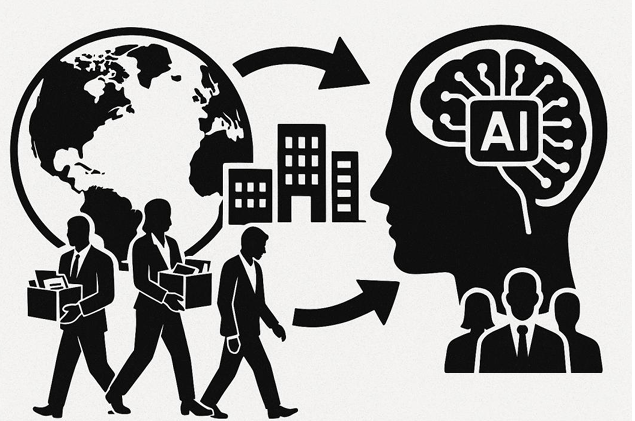
IBM (Global Tech): Automating HR and Upskilling Elsewhere
IBM provides a compelling example of how Al can both displace and create roles. In 2025, IBM's CEO confirmed that the company had used Al to replace several hundred Human Resources staff, roles traditionally involving many managerial tasks. The company's "AskHR" Al agent now automates 94% of routine HR inquiries and tasks (such as processing vacation requests and payroll queries). This massive automation initiative effectively eliminated a layer of HR coordinators and managers who used to handle those repetitive tasks. However, IBM did not simply pocket the savings, instead, they redirected the freed-up budget to hire more people in other areas. "Our total employment has actually gone up," CEO Arvind Krishna noted, explaining that Al-driven efficiency "gives you more investment to put into other areas". IBM hired more software developers, salespeople, and "critical thinking" roles that involve complex human interaction, jobs where employees "face off against other humans, as opposed to just doing rote process work". This case shows a dual effect: Al replaced a chunk of back-office managerial work, but IBM treated it as an opportunity to reskill or reallocate those resources into higher-value roles. Importantly, IBM's technical leaders claim a huge productivity boost, $3.5 billion over two years, from embracing Al across the business. The takeaway: even when Al displaces managers in one domain, a forward-thinking strategy is to invest in new roles (often requiring upskilling existing staff) that Al cannot fill. IBM's workforce transformation exemplifies turning an Al threat into an opportunity through strategic workforce planning.
NetDragon (China): The World's First AI CEO
In a move that grabbed global headlines, NetDragon Websoft, a Chinese technology and gaming company, appointed an Al program as the CEO of one of its divisions. In August 2022, the company introduced "Ms. Tang Yu," an Al-powered virtual humanoid, as the chief executive of its subsidiary in charge of daily operations. This is believed to be the first time a corporation put an Al in a CEO role. The results? Within the first six months, the AI CEO outperformed expectations, NetDragon's stock price rose 10% and beat the market index, adding roughly $1 billion to the company's valuation. The founder, Dejian Liu, said the bold experiment "represents our commitment to truly embrace the use of Al to transform the way we operate... and drive our future growth." Tang Yu's responsibilities included routine decision-making, data analysis for the business, and even performance evaluations of projects. Humans still handled creative strategy and major investments, but much of the day-to-day running of the division was algorithmically driven. NetDragon claims this Al leadership improved efficiency and eliminated bias or emotional sway in decisions. This case study is both awe-inspiring and unsettling, it shows just how far Al's role in management might go. If an Al can occupy a CEO seat (even nominally) and deliver positive results, one must ask: what does the future hold for middle managers? While most companies are nowhere near ready to hand the reins to a robot, NetDragon's experiment demonstrates the radical possibilities of Al in corporate governance. It serves as a wake-up call that even high-level managerial functions, analyzing business metrics, allocating resources, monitoring teams, can potentially be codified into algorithms. At the same time, the NetDragon story is something of a special case (perhaps even a publicity stunt), and human executives are still very much in charge elsewhere. But it underscores a crucial point: Al can now handle not just back-office tasks, but also decision-making and leadership support at high levels. Companies around the world are watching this experiment closely.
Microsoft (United States): Flattening Management Layers
We touched on Microsoft's 2025 layoffs earlier, here we revisit it as a case of a tech giant leveraging Al to restructure. Officially, Microsoft said the layoffs were about "simplifying organizational layers to boost efficiency". In practice, many observers noted it was a response to Al's rapid integration into workflows. Microsoft has invested heavily (over $80 billion in one year) in Al infrastructure and tools. With GitHub Copilot and other Al coding assistants writing substantial portions of code, Microsoft signaled that it needs fewer managers and coordinators in those areas. Indeed, among those laid off were product/project managers who traditionally act as liaisons between engineers, designers, and marketing. If Al can streamline product development (by automating code and even generating design suggestions), Microsoft apparently inferred it could streamline management oversight as well. This is essentially "quiet Al layoffs", job cuts not explicitly labeled as automation-driven, yet largely enabled by Al improvements. Interestingly, Microsoft did not cut in customer-facing or people-centric roles. Roles requiring a high degree of human empathy, creativity, and relationship-building (like sales, customer success, etc.) were largely untouched. The internal message seems to be: roles focused on technical execution can be thinned out via Al, while roles focused on human interaction remain vital. Microsoft's case teaches other large firms a lesson: adopting Al at scale often goes hand-in-hand with rethinking organizational structures and potentially removing intermediary roles that were once essential for information flow or coordination.
Klarna (Sweden): A Cautionary Tale in Over-automation
Not every Al-and-management story is a triumph. Klarna, a Swedish fintech company, experimented aggressively with Al in its customer service and experienced a setback. In 2022, Klarna made headlines by freezing hiring and replacing a large portion of its customer support agents with an Al chatbot, essentially removing team leads and reducing the need for customer service managers overseeing those agents. The goal was to cut costs and show that Al could maintain service levels. However, by mid-2023, Klarna reversed course. The company admitted the Al's performance wasn't meeting quality standards and brought back more human staff to ensure customer queries were handled well. Klarna's CEO Sebastian Siemiatkowski noted that while the Al chatbot could handle many routine inquiries (the work of "700 customer service agents," he claimed), it struggled with complex issues and nuances of human communication. The lesson from Klarna's case is that Al has limits, and rushing to eliminate too many roles without a robust Al that can truly fill the gap is risky. It underscores the importance of quality control and human oversight. For managers, this story is a reminder that not all managerial functions can be handed to Al on autopilot, especially those involving complex problem-solving, customer empathy, and adaptation to novel situations. The prudent approach is often to augment human managers with Al, rather than outright replace them, until the technology is unquestionably ready. Klarna's hiccup suggests that the human touch still matters, and companies must carefully balance efficiency with service quality. In a broader sense, it's a call for "responsible automation", implement Al in stages, monitor outcomes, and retain people in the loop where needed.
Other Notable Examples:
Many other organizations are navigating similar changes. Amazon, for instance, has openly used Al to manage parts of its workforce (from warehouse optimization algorithms to performance tracking of delivery drivers). In a 2023 memo, Amazon's CEO Andy Jassy acknowledged plans to use Al to "reduce our total corporate workforce" as efficiency gains are realized. This indicates even corporate-level roles (which include plenty of managers) are under review for potential Al-driven streamlining. Meanwhile, on the more positive side, some companies are using Al to assist managers rather than replace them, for example, by providing decision dashboards, predictive analytics for project risks, or coaching insights. We are also seeing new hybrid roles emerge, like "Al ethicist" or "automation team lead," which are often filled by people with managerial experience who pivot into overseeing Al systems. This brings us to our next section: how managers can adapt and find opportunity in this sea of change.
5. Timeline: Key Developments in AI and Management
To put these changes in perspective, below is a timeline highlighting major milestones and predictions in the Al-management story over the past decade and looking ahead:

Hedge Fund Automates Management. Bridgewater Associates, the world's largest hedge fund, announces an ambitious project to build Al software to automate day-to-day management decisions including hiring and firing, following founder Ray Dalio's vision. The Al "Principles Operating System" (PriOS) aimed to make many management choices based on data and Dalio's principles within five years. This early initiative signaled that even high-stakes people decisions could potentially be codified.
Gartner's Alarming Prediction. Gartner reports that by 2024, 69% of routine tasks done by managers will be completely automated. The news raises eyebrows across industries, painting a near-future in which Al-driven virtual assistants and chatbots handle the bulk of administrative management work. Gartner also forecasts that new managerial priorities will shift to learning, performance coaching, and Al oversight as automation expands.
The Management "Breaking Point." A BCG survey finds 37% of managers in Western countries believe their management layer will vanish by 2025. Additionally, only 9% of non-managers aspire to become managers. This occurs alongside the growing adoption of Agile methodologies that encourage flatter structures and autonomous teams. It's a moment of recognition that the traditional managerial career path is losing its allure - a trend likely accelerated by impending Al tools.
AI CEO and Flattened Hierarchies. In August, NetDragon Websoft appoints "Tang Yu," an Al, as CEO of a major division - arguably the first Al to hold an executive position. The experiment, publicized in 2023, shows strong results (stock value up +10% in 6 months). Around the same time, many companies worldwide experiment with reducing management layers, either through restructuring or by leveraging collaboration technology and Al. The concept of algorithmic management gains traction, notably in gig economy platforms where scheduling and oversight are entirely handled by software.
Generative AI Revolution. OpenAI’s ChatGPT (launched late 2022) and other generative AI explode into mainstream use. Millions of professionals, including managers, start using AI tools for writing, research, and analysis. This year also sees mass corporate responses: IBM pauses hiring for roles that AI could do, with its CEO estimating 7,800 jobs (mainly back-office managers/analysts) could be replaced in coming years. Surveys like Pegasystems’ report that 78% of executives foresee middle management ranks thinning due to AI. The World Economic Forum’s Future of Jobs 2023 highlights that by 2027, about 25% of jobs will change due to technology and automation (83 million lost, 69 million gained) – implying significant churn in roles including supervisors and coordinators.
Reality Hits Middle Managers. By this year, the effects predicted by Gartner and others are being felt. Microsoft conducts major layoffs, citing “organizational simplification,” but observers note AI is a driving factor in needing fewer managers in product development. IBM announces that its AI automation in HR has already replaced hundreds of jobs, and its AskHR chatbot handles 94% of HR service tickets autonomously. A report by Tech.co lists numerous companies, from e-commerce to media, that have openly admitted to using AI to eliminate positions in 2024-25. In the broader economy, the U.S. experiences the first notable waves of AI-related white-collar layoffs (some 4,000 job cuts in May 2023 were attributed directly to AI, according to Challenger, Gray & Christmas data). Mid-level managerial roles are frequently targeted in these efficiency drives.
The New Normal Emerges. Looking ahead, Gartner predicts 80% of today’s project management work will be eliminated as AI takes over traditional PM functions by 2030. This is indicative of a broader expectation that many process-driven managerial roles will either disappear or be radically redefined by this time. However, the hope is that by 2030, organizations have transitioned many former managers into new roles (such as AI trainers, strategic advisors, or coaches) and that education systems have caught up to prepare new entrants for an AI-centric workplace. The World Economic Forum envisions a massive reskilling imperative by 2030 – up to 1 billion people need to be reskilled globally to adapt to automation and AI shifts. By the end of the decade, the management function may look very different: fewer layers, more technology oversight, and managers who focus on distinctly human strengths. Those who cannot adapt may have already exited the traditional workforce or moved into gig/freelance roles. Those who do adapt could find themselves leading augmented teams, where AI is a ubiquitous collaborator on all projects.
This timeline illustrates that the AI disruption to management is not a sudden event but a trend building over years. We are living through the inflection point where early predictions are turning into concrete corporate actions. The next section explores how we can respond – how managers can evolve rather than go extinct.
6. From Threat to Opportunity: Rethinking the Manager’s Role
Faced with these stark realities, it’s easy to fall into despair as a manager. But as the saying goes, “This truth isn’t a death sentence for management; it’s an evolution.” In fact, if routine administrative duties are being taken over by AI, that clears the path for managers to focus on what truly adds value – the human-centered aspects of leadership that machines cannot replicate (at least not anytime soon). Rather than being the ones who fill out forms, shuffle data, or police minor procedures, future managers can be coaches, innovators, and strategists, leveraging AI to handle the grunt work.
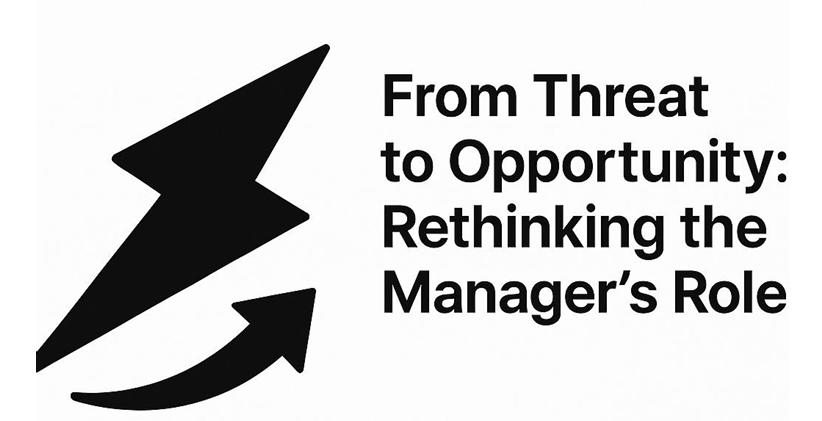
The Irreplaceable Human Skills
What is the “essential, irreplaceable core” of management that remains after AI strips away the tedious parts? It boils down to uniquely human qualities:
- Emotional Intelligence and Empathy: Understanding team members’ emotions, motivations, and challenges is something AI lacks. A great manager senses when an employee is disengaged or struggling, not just through metrics, but through conversation and body language. They provide encouragement, mentorship, and if needed, tough love, in a way a machine cannot. Building trust and psychological safety in a team requires genuine human connection. As one leadership expert quipped, “An AI can manage a workflow, but only a human can guide a human”. The future manager’s day might involve more one-on-one check-ins, career coaching, and removing roadblocks for people, rather than filling out status reports.
- Creative Problem-Solving and Adaptability: When an unprecedented situation arises, be it a global pandemic or a sudden market shift, past data won’t have all the answers. Human managers excel at navigating ambiguity, brainstorming creative solutions, and adapting plans on the fly. AI is great at optimizing within known parameters, but introducing a completely new approach (a bold marketing campaign, a reimagined product concept) often stems from human creativity. Managers can use AI for insights, but connecting the dots in novel ways and inspiring a team around a creative vision remains a human forte.
- Communication and Inspiration: Managers serve as the translators of organizational vision and the mediators in conflicts. They communicate context, meaning, and purpose, not just the “what” of tasks, but the “why.” AI can generate a speech or an email, but it doesn’t carry the authentic weight of a leader’s personality and experiences. Inspiring a team during tough times, celebrating wins in a heartfelt way, negotiating compromises between departments, these interpersonal skills are at the heart of effective management. The best managers are great storytellers and listeners, capable of rallying people around a goal. Those aspects of the role become even more critical when AI is doing the administrative heavy lifting.
- Ethical Judgment and Trust Building: AI can sometimes make recommendations that are efficient but possibly unethical or insensitive (for example, it might suggest performance based firings purely from data). Managers must inject human ethics and values into decisions. They consider fairness, long-term culture, and the company’s principles, and sometimes override what a cold algorithm would do. In the AI era, managers will be guardians of responsible use of AI, ensuring that decisions augmented or made by AI align with human values and don’t inadvertently harm morale or customer trust. This “moral compass” function is uniquely human.
- Developing Talent: Great managers coach their team members to grow, acquiring new skills and confidence. They identify someone’s potential and provide stretch opportunities or feedback to help them advance. AI can point out who is performing well or poorly by numbers, but it cannot mentor a person on how to improve their presentation skills or how to become a better leader themselves. The future manager will spend more time as a “talent developer”, which is both highly personal and strategic for the organization’s success.
In essence, managers must pivot from being taskmasters to being people masters. As AI handles tasks, the manager’s value is in maximizing the potential and performance of the humans on the team. This is reminiscent of the Agile notion of a “servant leader”, someone who leads by enabling and serving their team, rather than by controlling every detail. AI’s encroachment ironically forces managers to adopt this more empowering style, because micromanagement of tasks will simply be done better by the bots.
We see this mindset echoed by progressive organizations and thought leaders. The STAR★ Manager research group terms it “removing the administrator from the manager”. With AI automating administrative burdens, managers are free to truly lead. That means spending time on strategy, innovation, and human development. It’s telling that Gartner’s vision of future management expected that “by using AI to automate tasks, managers can invest more time on learning, performance management and goal-setting”. In other words, the soft skills become the hard skills of tomorrow’s managers.
Consider performance evaluations as an example. An AI might compile all the metrics and even write a first draft of an employee’s review. But deciding how to frame the feedback, how to motivate the person to improve, and how to tailor a growth plan, those steps require a manager’s personal touch. The manager of the future could walk into that meeting armed with rich AI-generated insights, but the conversation that happens is deeply human. Thus, the synergy is: AI provides the data, the manager provides the wisdom.
Another example is decision-making. AI can rank options or even choose one based on probability of success (as Bridgewater’s algorithms were intended to do for certain management decisions). However, employees might resist a decision handed down purely by a machine. As Devin Fidler of Institute for the Future noted, often “the decision is made by a statistical algorithm but conveyed by somebody who can put it in an emotional context.” People need a human face and narrative, especially for hard decisions. So, a likely role for managers is to interpret and contextualize AI-driven decisions. They become a liaison between the digital logic and the human team, explaining changes in a way that builds understanding and buy-in. This “AI liaison” role is a new twist on management that mixes technical understanding with empathy.
Crucially, managers themselves will use AI as a powerful tool in their toolkit. Instead of fearing it, savvy managers treat AI as a colleague, an assistant that can augment their capabilities. For instance, a manager might use a generative AI to draft project plans or team communications, saving time that they can reinvest in face-to-face interactions. AI can help analyze team engagement survey results and suggest who might be at flight risk or burnout, tipping off the manager to intervene early. We’re already seeing tools that act like an “AI chief of staff” for leaders, summarizing key information, scheduling priorities, and even prepping answers for meetings. Managers who learn to effectively delegate to their AI tools (while maintaining oversight) will excel. They’ll be able to handle larger teams or more complex projects because their AI is handling the low-level monitoring and reminders. In effect, the manager+AI duo can be a super-team: AI handling scale and data, the manager focusing on strategy and people.
7. Upskilling for an AI-Augmented Future
Turning the looming threat of AI into an opportunity requires action, particularly in the realm of skills development. Both individual managers and the organizations that employ them must invest in upskilling and reskilling to prepare for new roles and ways of working. As the World Economic Forum famously highlighted, 50% of all employees will need reskilling by 2025 due to automation and AI advances. Managers are no exception; in fact, they may need some of the most intensive reskilling, as their roles shift shape. Here we outline key areas for upskilling and how managers and companies can approach them:
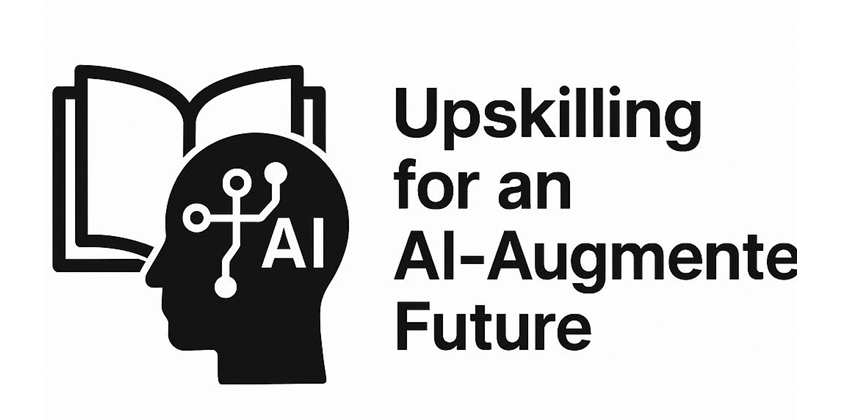
1. AI Literacy and Digital Skills:
It might go without saying, but every manager should seek to become fluent in the basics of AI and data analytics. This doesn’t mean turning into a software engineer, but it does mean understanding how AI tools work, their strengths and limitations, and how to incorporate them into daily workflows. For example, a mid-level marketing manager could take courses on using AI for data analysis or familiarize themselves with no-code AI platforms that forecast trends. If generative AI is available, learn prompt engineering to get the most useful outputs. The goal is to reach a point where using AI tools is as second-nature as using spreadsheets and email. Many companies are launching internal “AI academies” or training programs to raise the baseline skills of their workforce. Managers who participate actively demonstrate adaptability. Furthermore, knowing the capabilities of AI helps managers identify new opportunities to streamline work and even to develop new business ideas. It also helps them critically assess when an AI’s output is reliable or when to double-check (since AI can make mistakes or “hallucinate” facts). Essentially, digital acumen will be as important as domain expertise for managers going forward.
2. Human-Centric Leadership Skills:
As discussed, the human side of management is the refuge where managers can distinguish themselves from AI. Therefore, organizations should double-down on training programs that hone skills like emotional intelligence, active listening, coaching, conflict resolution, and creative thinking. Luckily, these are learnable skills. Many forward-looking companies are already revising their leadership development curricula to focus less on technical project management and more on “soft skills” (which are really the hard-to-automate skills). Methods like role-playing difficult conversations, mentorship programs, and cross-functional team projects can build a manager’s confidence and competence in interpersonal arenas. Some firms encourage managers to get certifications or training in coaching (for example, the STAR® Manager program emphasizes “Operational Coaching®” as a daily management style). The idea is to train managers to shift from directive, top-down habits to facilitative, coaching habits. This not only makes them more “AI-proof” but also tends to improve team performance and engagement in its own right.
3. Continuous Learning Mindset:
Perhaps the most important skill is the ability to keep learning new skills. In a rapidly changing environment, static knowledge can become obsolete fast. Managers should cultivate curiosity and flexibility, essentially becoming “adaptability natives.” This might involve learning on the job (taking on stretch projects in unfamiliar areas), as well as more formal means (attending workshops, getting micro-degrees, or simply devoting a few hours each week to learning something new). Companies can support this by giving managers dedicated learning time and resources. Some have instituted 80/20 rules (80% core work, 20% learning/innovation time) or education budgets for each employee. When employees see their managers learning (e.g., a sales manager learning Python to better analyze data, or an HR manager learning about data privacy in AI), it sets a powerful example and creates a culture where change is embraced. A McKinsey report found that millennials in management are often advocates for AI and change, and they can help their more reluctant peers by sharing knowledge and enthusiasm. Fostering peer learning groups around AI tools, or having “AI champions” in each department, can be effective ways to spread know-how.
4. Domain Expertise with an AI Twist:
Managers will still need deep knowledge of their business domain, be it finance, marketing, operations, etc. But the way they apply that expertise may change. Training programs should integrate AI into the domain context. For instance, a finance manager might need to learn how AI is used in algorithmic trading or fraud detection, and how that affects financial oversight and decision-making. A supply chain manager should learn about AI-driven demand forecasting and what new risks/opportunities it brings (like needing to manage the algorithm’s performance as well as the team’s). In essence, managers should evolve into “AI informed subject matter experts.” This might involve cross-training: pairing tech people with seasoned managers in workshops to learn from each other. Some organizations rotate managers through stints in data science teams or IT innovation hubs to get exposure. The benefit is two-way: managers pick up tech knowledge, and tech teams pick up business savvy.
5. Collaboration and Agile:
Given that hierarchy may flatten, managers might find themselves leading more cross-functional teams or temporary project squads rather than static departments. Agile project management approaches (originating in software but now widespread) emphasize iteration, feedback, and servant leadership. Upskilling in agile (Scrum, Kanban, etc.) can help managers remain relevant as team leaders in dynamic settings. Agile ways of working often reduce the need for tight control and encourage team members to self-organize around clear goals. A manager in an Agile organization acts more as a facilitator, removing impediments, aligning the work with business priorities, and ensuring communication flow, which aligns well with the concept of focusing on what AI can’t do (providing context, motivation, and judgment). Companies may consider certifying their managers in agile project management or running internal agile pilots with managers given coach roles. This not only helps integrate AI (since agile teams iterate and adapt quickly, they can incorporate AI tools faster), but also helps reshape the role of manager into a more resilient, future-proof form.
From an organizational perspective, HR and L&D leaders have a huge part to play. They should start with a skills gap analysis: what skills do our managers currently have, and what will they need in an AI-rich environment? Many will find gaps in data literacy, technology comfort, or advanced interpersonal skills. Then, design learning journeys to bridge those gaps. These could include formal courses, but also experiential learning such as hackathons (where managers team up with AI specialists to solve a problem) or stretch assignments (like tasking a manager to implement a new AI tool in their department). Another strategy is to create mentoring pairs, perhaps pair a young, tech savvy employee with a veteran manager, so they can teach each other (tech skills flowing one way, leadership wisdom flowing the other). This fosters mutual growth and breaks down resistance between generations or skill groups.
Crucially, companies should communicate to managers that upskilling is part of the new deal. Just as the organization invests in technology, it will invest in people, but employees must also invest time and effort in continual learning. This can be framed positively: those who upskill will have exciting new career paths open up. For example, a mid-level operations manager who learns about AI might move into a new role as an “AI implementation lead” for the company’s supply chain systems, a role that didn’t exist before. Or a marketing manager who gains expertise in AI-driven customer analytics might become the head of a new Customer Insights team, blending AI and human analysis. By showcasing such opportunities and even creating internal career transitions, companies can retain and motivate managers. It’s far better to retrain a loyal manager of 10 years into a new valuable role than to let them go and try to hire new talent from scratch.
The stakes are high. Analysts talk about a coming “reskilling revolution”, and it’s not hyperbole, the WEF projected that globally, one billion people will need to be reskilled by 2030 to meet the demands of the Fourth Industrial Revolution (AI, automation, etc.). Organizations that act now will avoid severe talent crunches later. Those that don’t invest in their managers may find themselves with a hollowed-out middle: automated processes on one side, and a few overwhelmed executives on the other, with nobody in between to translate strategy into execution or to develop the next generation of leaders. In that scenario, companies risk stagnation, cultural deterioration, and even brand damage (since managers often shape customer and employee experiences).
Finally, upskilling isn’t solely about hard skills. Emotional support and mindset shifts are also needed. Many managers will understandably feel threatened or uncertain during this transition. Companies should offer change management programs, coaching, or even counseling to help managers process these changes. Peer support groups (formal or informal) where managers can share challenges and successes in adopting AI can help normalize the journey. Leadership should reinforce that adapting to AI is not an indictment of one’s past work, but rather a strategic move to secure the future. Those managers who embrace a growth mindset, seeing AI as a tool to master, not a monster to fear, will likely become the future stars of the organization.
The age of AI is undeniably a disruptive one for mid-level managers, but it need not be a disastrous one. Yes, AI will fundamentally reshape managerial roles, many routine aspects of management are already being automated, and organizational structures are evolving to be leaner and more agile. However, as we’ve argued, this is as much an opportunity as it is a threat. By shedding the drudgery of admin tasks, managers can reclaim their time for true leadership: coaching employees, driving innovation, and strategizing for the future. In short, AI is forcing an inflection point in management. Those who adapt will find themselves leading more meaningful, human-centric work than ever before, often with the aid of AI tools that make them even more effective. Those who resist change, unfortunately, may find the world moving on without them. For organizations, the writing on the wall is clear. Preparing your management cadre for the AI era is not optional, it’s an urgent strategic imperative. This means investing in technologies and in people, redesigning processes to integrate AI-human collaboration, and fostering a culture where continuous learning is valued over static job descriptions. Companies that navigate this well will likely see higher productivity, better decision-making, and more engaged teams, as mundane friction is eliminated and human talent is focused where it counts. Those that fail to plan may experience the worst of both worlds: layoffs without true efficiency gains, surviving managers who are demoralized and under-skilled, and a leadership pipeline that has dried up.

8. What can you do starting today?
As a manager, begin by assessing your own daily tasks: Which of these could an AI do, and which require uniquely human judgment? This simple exercise can highlight where to double-down on your development. Talk to your team about AI, chances are some are already experimenting with it. Encourage sharing of tips and tools. Perhaps pilot an AI assistant on a small project to familiarize everyone with its potential and quirks. Simultaneously, seek out opportunities to strengthen your human skills, volunteer to mentor a new hire, or to lead a brainstorming session, activities that flex the muscles robots don’t have. By proactively reshaping your role, you make yourself less replaceable and more valuable.

For HR and L&D leaders reading this, consider conducting an audit of how AI might disrupt each function in your organization. Who is at risk, and how can you turn that risk into a reskilling success story? Partner with those in strategic planning and IT to align on a roadmap: technology implementation on one side, training and change management on the other. One without the other will not work.
Lastly, remember that you don’t have to navigate this transition alone. AgileWoW is here to help. As a consulting and training partner specialized in agile transformations and AI readiness, AgileWoW has assisted numerous organizations in upskilling their workforce and redesigning their management practices for the future. We offer workshops, coaching programs, and hands-on training that equip mid-level and senior managers with both the technical understanding of AI tools and the soft skills needed to lead in an AI-enhanced environment. Our approach is empathetic and customized, we understand the human side of this change, and we work with you to build not just skills, but confidence and vision.
We invite you to join AgileWoW’s upcoming workshops and training sessions. In these sessions, you’ll get to experiment with the latest AI tools relevant to your field, learn best practices from companies that successfully transitioned their managers, and develop a personalized upskilling plan. You’ll also connect with a community of forward-thinking leaders who, like you, are turning uncertainty into opportunity. Whether you’re a mid-level manager wondering how to stay relevant, or an HR/L&D leader crafting your company’s strategy, there’s something in our programs for you.
The future of management is still being written. By taking initiative now, learning, adapting, and seeking the right support, you can ensure that you and your organization not only survive the age of AI, but truly thrive in it. Embrace the tools, invest in your talent, and reimagine what management can be. The companies and managers who do so will shape the next era of business, one where human creativity and machine intelligence work hand-in-hand to achieve extraordinary outcomes.
Let’s embark on that journey together. Prepare, upskill, and lead on, the future is waiting.
9. Sources and References
- Gartner prediction on management automation (2020) – Entrepreneur Media
- Pegasystems survey on AI reducing middle management – Medium (Sushant Vohra)
- “Will AI Replace Managers? – The Uncomfortable Truth” (STAR® Manager blog) – on managerial tasks being automated and the evolving role
- Microsoft layoffs and AI factor – Marketing AI Institute / Bloomberg
- BCG “End of Management as We Know It” survey (2020) – on managers’ outlook
- World Economic Forum Future of Jobs Report 2023 – job disruption statistics
- IBM case study – AI in HR and 94% task automation (CEO Arvind Krishna interview)
- NetDragon case study – AI CEO Tang Yu and outcomes – The Independent (2023)
- Andy Jassy (Amazon) memo on AI reducing workforce – Tech.co (2025)
- Microsoft CTO on AI coding 95% by 2030 – Marketing AI Institute
- Klarna case study – AI replacing 700 agents then reversal – Marketing AI Institute / Futurism
- Gartner (2030) forecast 80% of PM work automated – HBR / Visor.us
- WEF reskilling statistics – Chief Learning Officer (Phillip Campbell, 2023)
- McKinsey 2024 study – employees using AI and eager to reskill – McKinsey Report 2025
- Guardian (2016) – Bridgewater developing AI management system (PriOS)
- Devin Fidler quote on algorithmic decisions needing human interface – The Guardian




